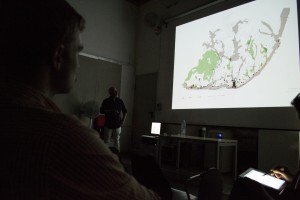Last Thursday, Cornell in Rome hosted a lecture led by João Luís Carrilho da Graça in our main lecture room at the Palazzo Lazzaroni. For those of you not very familiar with his work, he is responsible for the very acclaimed pedestrian bridge in Colvilhã, Portugal, which spreads over the Carpinteira stream and was finished in 2009.
João Luís, whom we also had the pleasure of having as a guest critic for our architectural studio reviews that same day, is a contemporary Portuguese architect who’s been featured in El Croquis, and has been the recipient of several important architectural awards, including the Piranesi Prix de Rome prize in 2010, and the “FAD” prize in 1999. He holds a practice in Lisbon and is particularly interested in topography, land, ridges, valleys, and ancient streets.

‘One Stone’, as the lecture was called, is really about the available resources of the site in which his architecture takes place.
Maps, maps, maps.
Ridges, valleys, ridges.
Maps.
Water, land.
Street.
Ancient, modern; old, new.
Ridges, valleys, ridges.
Maps.
Water, land.
Street.
Ancient, modern; old, new.
These are all studies and things that prefaced the projects that were discussed on the lecture.
“The city is an ephemeral thing that changes”, he says; and in so, his proposals mainly deal with existing conditions, and his reinterpretations of them. They’re mostly about highlighting what was once on the site, brought about with a new lens that speaks of the zeitgeist, and goes back and forth between old and new.

João Luís thoroughly walked us through the Archeological Museum of Praça Nova do Castelo de São Jorge, and presented his site-inscribed object which floats above the ruins of two Islamic houses, and lights up to highlight excavations and history. He took us to the Lisbon Cruise Terminal, which I understood was about creating a seamless connection between the city and its cruise port, by making a hub within a forest.
We saw his Campo das Cebolas intervention, which also floated above the ground, and made room in the hectic city for trees and urban breaks. Consequently, we explored the intervention in the historical center of Évora, and finally the Carpinteira pedestrian bridge, which created a new landscape within the city’s mountain and valley formations, was rectangular in form, and connected both elements both conceptually and geographically.
This, as many other of his projects, is almost surreal in essence. They’re seamless, but at the same time very present, iconic, and resolved to alleviate pre-existing conditions of a site.
“To seduce, or to fascinate?”, he asked, referring to architecture, by the end of his talk. Seduction, he says, is a theatrical process that involves a choreography. Fascination, on the other hand, is whether you like it, or not. The invitation is to seduce, rather than fascinate, as we design and build… to meticulously decide what spaces do to users, and how, and why. Seduce, and be seduced.
For more information on Carrilho da Graça, visit his website, http://www.jlcg.pt/

